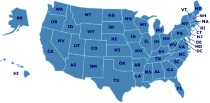Westward Expansion
Things to See & Do in New Mexico
Old West Books
Phone: 719-260-6030
Email: info@oldwestbooks.com
Old West Books has been in business since 1997 and specializes in books on the American West, Custer, military, Civil War, Indian Wars, cowboys, cattle industry, fur trade, Lewis and Clark, travel and exploration. They stock a mix of rare out-of-print books and new titles. Books are shown by appointment only. Books may also be bought via the Internet, catalogs, and book shows.
Old Spanish National Historic Trail
Salinas Pueblo Missions National Monument
El Camino Real de Tierra Adentro National Historic Trail
Santa Fe National Historic Trail
Pecos National Historical Park
Featured Resources
As an Amazon Associate, we earn from qualifying purchases. We get commissions for purchases made through links on this site.





